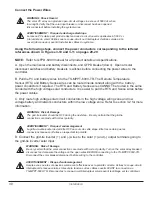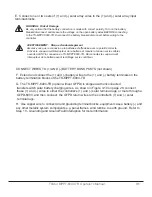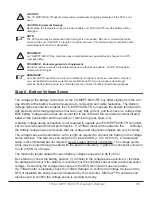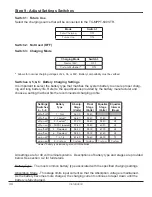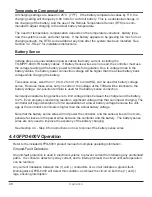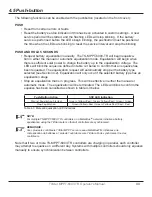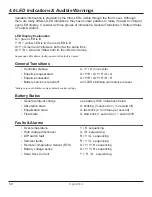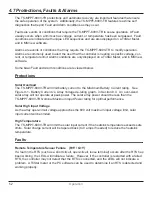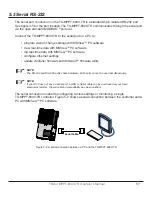
43
TriStar MPPT-600V-TR Operator's Manual
Certain battery types benefit from a periodic boost charge to stir the electrolyte, level the cell
voltages, and complete the chemical reactions. Equalize charging raises the battery voltage
above the standard absorption voltage so that the electrolyte gasses. The green SOC LED will
blink rapidly two (2) times per second during equalization charging. The duration of the equalize
charge is determined by the selected battery type. See table 4-1 in this section for more details.
The
Equalization Time
is defined as time spent at the equalize set-point. If there is insufficient
charge current to reach the equalization voltage, the equalization will terminate after an addi-
tional 60 minutes to avoid over gassing or heating the battery. If the battery requires more time in
equalization, an equalize can be requested using the TriStar Meter or push-button to continue for
one or more additional equalization cycles.
The Equalize set-point is temperature compensated if the RTS is connected.
When to Equalize
The ideal frequency of equalizations depends on the battery type (lead-calcium, lead-antimony,
etc.), the depth of discharging, battery age, temperature, and other factors. One very broad
guide is to equalize flooded batteries every 1 to 3 months or every 5 to 10 deep discharges.
Some batteries, such as the L-16 group, will need more frequent equalizations.
The difference between the highest cell and lowest cell in a battery can also indicate the need
for an equalization. Either the specific gravity or the cell voltage can be measured. The battery
manufacturer can recommend the specific gravity or voltage values for your particular battery.
Why Equalize?
Routine equalization cycles are often vital to the performance and life of a battery - particularly in
a solar system. During battery discharge, sulfuric acid is consumed and soft lead sulfate
crystals form on the plates. If the battery remains in a partially discharged condition, the soft
crystals will turn into hard crystals over time. This process, called “lead sulfation,” causes the
crystals to become harder over time and more difficult to convert back to soft active materials.
Sulfation from chronic undercharging of the battery is the leading cause of battery failures in
solar systems. In addition to reducing the battery capacity, sulfate build-up is the most common
cause of buckling plates and cracked grids. Deep cycle batteries are particularly susceptible to
lead sulfation.
Normal charging of the battery can convert the sulfate back to the soft active material if the
battery is fully recharged. However, a solar battery is seldom completely recharged, so the soft
lead sulfate crystals harden over a period of time. Only a long controlled overcharge, or equal-
ization, at a higher voltage can reverse the hardening of sulfate crystals.


